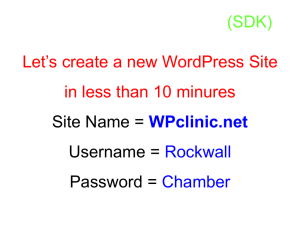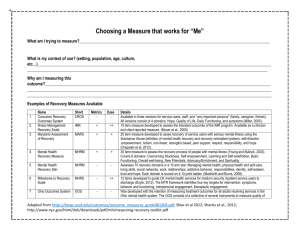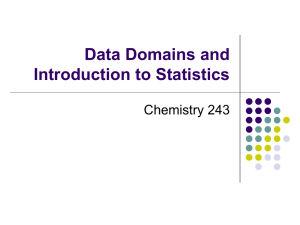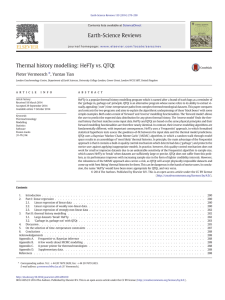(U–Th)/Ne and multidomain (U–Th)/He systematics of a
advertisement
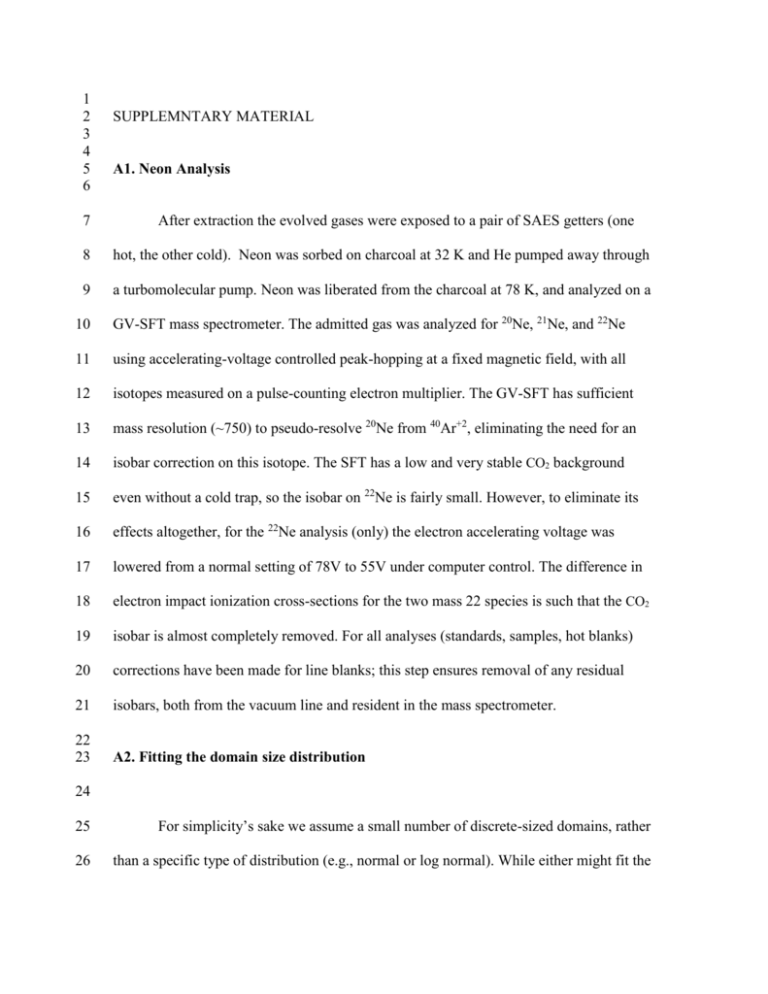
1 2 3 4 5 6 7 SUPPLEMNTARY MATERIAL A1. Neon Analysis After extraction the evolved gases were exposed to a pair of SAES getters (one 8 hot, the other cold). Neon was sorbed on charcoal at 32 K and He pumped away through 9 a turbomolecular pump. Neon was liberated from the charcoal at 78 K, and analyzed on a 10 GV-SFT mass spectrometer. The admitted gas was analyzed for 20Ne, 21Ne, and 22Ne 11 using accelerating-voltage controlled peak-hopping at a fixed magnetic field, with all 12 isotopes measured on a pulse-counting electron multiplier. The GV-SFT has sufficient 13 mass resolution (~750) to pseudo-resolve 20Ne from 40Ar+2, eliminating the need for an 14 isobar correction on this isotope. The SFT has a low and very stable CO2 background 15 even without a cold trap, so the isobar on 22Ne is fairly small. However, to eliminate its 16 effects altogether, for the 22Ne analysis (only) the electron accelerating voltage was 17 lowered from a normal setting of 78V to 55V under computer control. The difference in 18 electron impact ionization cross-sections for the two mass 22 species is such that the CO2 19 isobar is almost completely removed. For all analyses (standards, samples, hot blanks) 20 corrections have been made for line blanks; this step ensures removal of any residual 21 isobars, both from the vacuum line and resident in the mass spectrometer. 22 23 A2. Fitting the domain size distribution 24 25 For simplicity’s sake we assume a small number of discrete-sized domains, rather 26 than a specific type of distribution (e.g., normal or log normal). While either might fit the 27 data the former type of distribution is far easier to introduce into a forward model to 28 compute expected ages in each domain on arbitrary time-temperature paths. The 29 objective is thus to find a (preferably small) number of domains of a given dimension and 30 volume fraction that make up the sample. There are several inter-related quantities that 31 we could use as the fitting target for this exercise: the Arrhenius array, the individual 32 fractional yields for each step, the cumulative yields, or the ln(r/ro) plot. Ultimately we 33 found that equally weighting the fractional yield and the cumulative yield converged 34 rapidly on a high quality fit to all of these quantities. 35 36 37 In an MDD model with N discrete domain sizes, the total diffusant yield in step j is: 𝑁 38 𝐹𝑇𝑗 = ∑ 𝑣𝑖 𝐹𝑖𝑗 𝑖=1 39 Where vi is the volume faction of domain i and Fij is the yield from domain i in step j. 40 The individual Fij values can be forward modeled from the standard release equations 41 (Fechtig and Kalbitzer, 1966) assuming: 42 𝐷 𝐷𝑜 −𝐸𝑎 2 = 2 exp( 𝑅𝑇 ) 𝑎𝑖 𝑎𝑖 43 Where ai is the radius of domain i, Ea is the activation energy (e.g., established from the 44 measured Arrhenius plot), R is the gas constant, T the Kelvin temperature of the step, and 45 Do the diffusivity at infinite temperature. Because we have no way to independently 46 establish a, we never separate the convolved quantity D/a2. Thus we simply assume an 47 arbitrary value of Do, constant for all domains. 48 49 Using these equations we then simulate the step heat that produced the diffusion data in 50 Table S1. Ln(r/ro) is computed from a reference line that essentially goes through the 51 first data points on the Arrhenius plot and with activation energy Ea. Note that the exact 52 position of this line is irrelevant; different values simply shift the ln(r/ro) plot vertically. 53 54 For an MDD model with N domains there are 2N-1 free parameters (volume fraction and 55 size of each domain less the constraint that all volume be accounted for). We used the 56 Excel solver function to identify the parameter set that minimizes the mismatch between 57 modeled and observed yield data. By trial and error we established that about 7 domains 58 are required to match the observations; addition of more domains does not substantially 59 improve the misfit at least for this sample. While this is a large number of free 60 parameters, our goal is to match the data as well as possible, rather than to describe it in 61 the most parsimonious way. 62 63 A3. Assessing cooling paths using HeFTy 64 65 We used HeFTy (Ketcham, 2005) to compute bulk ages and age spectra on arbitrary 66 time-temperature paths for comparison with the equivalent measurements. We ran HeFTy 67 in the “inversion” mode to compute (and record) results for a large number of randomly 68 selected time-temperature paths and for each of the domains associated with each aliquot. 69 We used the mean activation energy (157 kj/mol) and assumed it remains constant 70 through time (i.e., we assume the absence of radiation damage effects). Because HeFTy 71 does not have the capability to reconstruct the aggregate sample by adding the individual 72 domains together, we exported the data to a file for further processing. 73 74 To compare the HeFTy output with the measured results, we first computed the bulk age t 75 tT for each time-temperature path from the ages of each domain, ti: 76 𝑁 77 𝑡𝑇 = ∑ 𝑣𝑖 𝑡𝑖 𝑖=1 78 79 Computing the bulk age spectrum is more involved because we must simulate the 80 diffusive loss of each domain (smaller domains degas before larger domains) and then 81 add them together with their appropriate weighting. The HeFTy model age spectrum for 82 each domain size consist of pairs of Fcum and age values, with Fcum incremented by 1% 83 between steps. Each of these Fcum values can be mapped to a specific release coordinate 84 (Watson et al., 2010); in an isothermal experiment the release coordinate is just Dt/a2 85 where t is cumulative time. By normalizing to ai2, we can compute the relative degassing 86 time t associated with each of these release fractions in an isothermal experiment. Small 87 domains reach high release fractions at short times, while large domains reach 88 comparably large release fractions only after longer times. Thus we have a schedule from 89 which we can compute when each domain contributes its helium to the aggregate 90 synthetic step heat. In practice we make a table of the release times and associated ages 91 for each step of all N domains. We then sort this table by increasing release time. A 92 model age spectrum for the aggregate is then produced by summing up the volume 93 weighted incremental release values for 3He, and the volume weighted average step ages, 94 for a series of sequential steps in the table (see Figure A2). We found that adding 15 95 sequential entries together produced an adequate resolution (for 7 domains with 100 96 model steps each, adding them together in groups of 15 creates 700/15= 46 steps in the 97 model age spectrum). 98 99 Figure Captions 100 101 Figure A1. SEM images of Redwall hematite. Note the abundant open pores (black 102 regions) and the individual crystallites within and projecting into the pores. EBSD 103 revealed only hematite in the regions shown. 104 105 Figure A2. 3He diffusion Arrhenius plots for aliquots A,B, C, and CuOx. 106 107 Figure A3. Construction of the multidomain “sample” from the model age spectra for 108 each individual domain. Computed for the reference path and for the domain spectrum 109 model of aliquot A. 110 111 112



